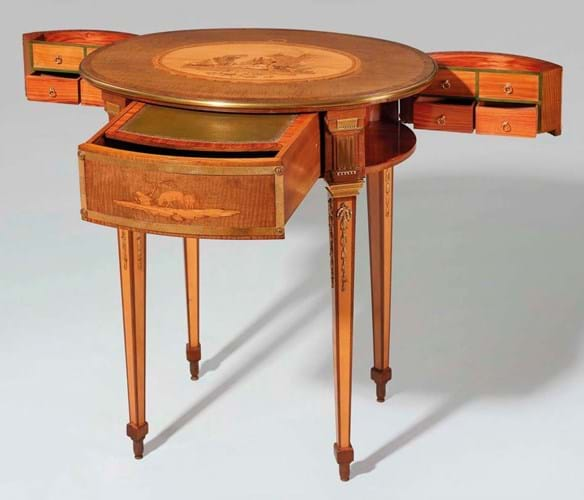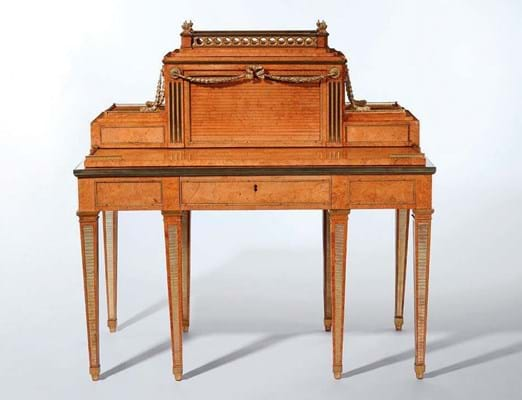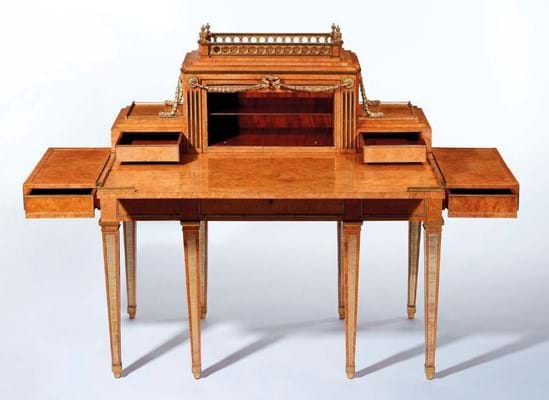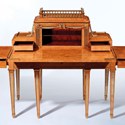
For some people Friday the 13th is not the most auspicious day to hold an auction, but Lempertz (25% buyer’s premium) in Cologne had no problems on November 13.
From four consignors the saleroom had acquired 15 works by the most accomplished German cabinetmakers of the late 18th century, Abraham Roentgen and his son David, which they offered under the title Fit for a King. On the day, there was lively bidding and only two lots failed to sell; all the others went to private collectors.
It is thought that the Roentgens created some 2000 pieces in all, the majority destined for the residences of European royal houses and members of the aristocracy.
After an apprenticeship with his father, Abraham travelled to the Netherlands and subsequently to London, where he arrived in 1733. Here he perfected his craft and encountered new techniques and decorative elements that he later applied to the furniture he created, in particular his use of inlays which were a prime characteristic of his works
In London Abraham became a member of the Moravian Church and from then on the ethics of the Pietist church shaped his life and his work. He instilled these ideas in his eldest son David, who was to become his successor.
Remarkable pieces
Abraham returned to Germany and eventually founded a workshop in Neuwied on the Rhine, where the Moravian Church was tolerated by the local ruler Count Friedrich Alexander zu Wied-Neuwied.
There he created remarkable pieces of furniture, among them a writing cabinet from c.1765, which took the top price at the Cologne sale. The cabinet, with intricate floral inlays, was inspired by a French Secrétaire à abattant. Abraham used an impressive variety of woods: red satinwood, tulipwood, kingwood, snake wood, burr walnut, holly, hornbeam, maple, oak and cherry.
The cabinet had an interesting provenance, having belonged to an English family called Peters from the late 19th century until 1984, when it was auctioned by Phillips in London. It was bought there by a German dealer who passed it on to a collector in Westphalia, who consigned it to Lempertz. It was knocked down for a low-estimate €300,000 (£272,727).
Dating from the mid-18th century, a table centrepiece or tray, decorated with rhombus-shaped marquetry, is one of a kind in the oeuvre of Abraham. No other examples of this design are known. It had once belonged to Dietrich Fabian, author of the definitive work on Roentgen furniture. It changed hands within estimate for €22,000 (£18,180).
After David had taken over from his father, things did not always run smoothly. In the late 1760s, the workshop was under threat of closure. The after-effects of the Seven Years’ War (1756-63) had put an enormous strain on the family finances and it was only through a lottery in 1769 that David was able to reduce the stock in his warehouse and ensure the survival of the company.
Many of his works incorporated hidden mechanisms to release drawers and sliding side compartments. This applied to an oval table from 1775-80, which transforms into a writing desk (previewed in ATG No 2461). It opened the Cologne sale and was knocked down for a lower-estimate €150,000 (£136,360).

An oval table which transforms into a writing desk, veneered and inlaid with rosewood, walnut, elm and other woods. It was made by David Roentgen between 1775-80 and has his monogram incorporated into the inlay. It sold for €150,000 (£136,360).
The imperial provenance of another, slightly later writing desk, veneered in thujawood, probably contributed to its final price. It had once belonged to Kaiser Wilhelm II, who bought it in 1918. Sixty years later, it was sold by Sotheby’s in Monaco and since then had belonged to a German collector.
It went €10,000 over the upper guide and sold for €210,000 (£190,910).
Paris workshop
After a visit to Paris in 1774, David established a workshop there, where he sold not only pieces imported from Neuwied, but also furniture he manufactured in the French capital.
He absorbed and adapted the fashions of the times, as can be seen in a finely inlaid cylinder bureau from the 1780s, which reflects the transition from Rococo to Classicism. Once again, David used a wide variety of different woods and veneers and also incorporated a spring mechanism to release the drawers.
Having once belonged to the Arnault Collection, the bureau had spent the last four years in the home of a private owner in Brussels and now changed hands for €170,000 (£154,545), just shy of the lower estimate.
From the same period, but manufactured in Neuwied, a mahogany chest of drawers attracted considerably more interest. From its creation until 1942, the chest had belonged to Roentgen’s family and their descendants. It then disappeared from view for many decades and resurfaced at Christie’s in London in 2012. More recently it had belonged to a German collector. It went over the top guide to sell for €260,000 (£236,360).
More affordable, but still classic examples of the artistry of the cabinetmaker, were the small caskets manufactured by Abraham, which concluded the sale. They were all made in c.1755.

Small caskets, such as this one in burr walnut, rosewood and cherry veneer, built by Abraham in the 1750s, were a specialty of the Neuwied workshop. The finely inlaid box changed hands for the estimated €30,000 (£27,270).
An example in burr walnut, rosewood and cherry veneer went for the predicted €30,000 (£27,270), while a silver mounted box with mosaic inlays in mahogany, cherry, satinwood and ebony, containing a hidden compartment, was knocked down below estimate at €32,000 (£29,090).
The final lot in the Cologne sale was a shallow document box, veneered in olivewood, mahogany and kingwood, which sold for the expected €25,000 (£22,730).
£1 = €1.10


















